#the music of the lord of the rings films
Text
it fucks me up by the way that EVEN as gollum literally attacks Sam and Frodo at the Crack of Doom, the music that plays for him is his Gollum's Pity theme, also called Sméagol's Theme, rather than Gollum's Menace (Gollum's Theme). the score itself still feels pity and mercy for him even when he's at his worst
#howard shore you never cease to make me cry#lotr soundtrack#doug adams#the music of the lord of the rings films#tagging this book because reading it is what prompted this post#gollum#smeagol#it's mine my own my precious
463 notes
·
View notes
Text
An incomplete list of movies where the composers did NOT have to go that hard
How To Train Your Dragon (2010) - I put Test Drive on my study playlist but I can never focus to it bc I'm too busy ascending. what is that motif and why does it do that to me. I've never even seen the movie.
Tarzan (1999) - nothing has ever affected me more than 80s pop star Phil Collins singing about a boy raised by gorillas
Lord of the Rings (2001-2003) - no explanation needed.
let me know which ones I missed lol
185 notes
·
View notes
Text
I guess I’m one of those weirdos who so deeply feels the essence of an instrumental leitmotif from a film score associated with a particular character or couple, that I start associating said leitmotifs in my head with ANOTHER character from an entirely different film/book/series. And I’ve built up a whole library of leitmotifs for LOTR characters even though I ADORE Howard Shore’s original score for the trilogy. I consider these leitmotifs to be add-ons, NOT replacements.
Nor do I intend to completely dissasociate all of these themes from their intended films/characters; some of them are perfect fits for the films they were written for. It’s just my mind going wild like usual. (But I admit, in some cases, the pieces are from films I dislike, and thus I would rather see these great songs associated with something of LOTR quality rather than what they were actually stuck with, especially when the lack of lyrics gives you the freedom to let the melody take you wherever it takes you, personally.)
In the case of Silmarillion characters and relationships, well, it’s a different story - it really is my attempt to cobble together what could be a hypothetical score, if it were brought to the screen. Obviously it’d never be this exactly, but I would hope a composer for a potential screen adaptation of The Silmarillion might be inspired by themes like these.
In some cases, the characters these themes were originally written for don’t resemble the corresponding LOTR characters very much, or at all. Also some of them have titles that by themselves could not be more different from and unfitting for Tolkien’s world. It’s just the melodies on their own, without context or even name, performed by these gorgeous orchestras, that have come to remind me of particular Tolkien figure(s).
I also have found lots of “love themes”, both romantic and platonic, for character relationships, as you’ll see. I’ve included romantic themes for canonical couples, as well as for pairings that I personally ship. I know Shore already gave Aragorn and Arwen a theme, but as I said, these are all extra additions and not replacements.
And yes I have a lot of Star Wars stuff in here, because I love Star Wars…but I love Tolkien more.
For the heck of it I’ll share some of these, with links to each song on YT. It’s hard to explain why I made these choices/associations, but maybe you’ll get it if you listen to some of them.
CHARACTER THEMES
Frodo = “Romeo” by Nino Rota
Sam = “Rey’s Theme” by John Williams
Aragorn = “The John Dunbar Theme” by John Barry
Gandalf = “Yoda’s Theme” by John Williams
Legolas = “Rose Tico” by John Williams
Lúthien = “Once Upon a Time in the West” by Ennio Morricone
Éowyn = “Marion’s Theme” by John Williams
The Valar = “Guardians of the Whills Suite” by Michael Giacchino
THEMES FOR LANDS/LOCATIONS
The Undying Lands = “Out of Africa” by John Barry
ROMANTIC LOVE THEMES
Frodo x Sam = “Love Theme from Ben-Hur” by Miklos Rozsa
Beren x Lúthien = “Love Theme from The Godfather” by Nino Rota
Faramir x Éowyn = “Han Solo and the Princess” by John Williams
Aragorn x Arwen = “Love Theme from Cinema Paradiso” by Ennio Morricone
Sam x Rosie = “Love Theme from Dances with Wolves” by John Barry
Bilbo x Thorin = “Wuthering Heights” (1970) by Michel Legrand
Thingol x Melian = “Indecent Proposal” by John Barry
Fingon x Maedhros = “Wuthering Heights” (1939) by Alfred Newman
Finrod x Bëor = “The Scarlet Letter” by John Barry
Aegnor x Andreth = “Laura” by David Raksin
Túrin x Beleg = “Across the Stars” by John Williams
Tuor x Idril = “Conversation Piece” by Bernard Herrmann
Eärendil x Elwing = “Tennessee” by Hans Zimmer
PLATONIC RELATIONSHIP THEMES
Legolas & Gimli = “Rain Man” by Hans Zimmer
Boromir & Faramir = “Luke and Leia” by John Williams
Bilbo & Frodo* = “The Mother’s Love” by Miklos Rozsa
Elrond & Elros = “Brothers” by Hans Zimmer
I may add to this as I think of more, or even replace certain songs entirely if I come across a better match.
* Bilbo & Frodo’s melody is heard in the first minute of the linked track, 0:00–1:01, and again at 1:48. Also, the love theme I associate with Frodo & Sam starts playing at 1:03, making this whole thing fit all the hobbits even better.
#lotr#jrr tolkien#lotr books#lord of the rings#film music#frodo baggins#samfro#frodo x sam#bagginshield#bilbo and frodo#legolas and gimli#eowyn x faramir#eowyn#aragorn#gandalf#luthien tinuviel#beren and luthien#aragorn x arwen#boromir#faramir#valinor#nienna#the valar#bilbo x thorin#farawyn#leitmotif
35 notes
·
View notes
Text
Do Sauron and Galadriel already have their own theme?
Alright my fellow Rings of Power soundtrack nerds, this one's for you.
I noticed there's a beautiful, tragic motif that appears twice in the music behind two of Galadriel and Halbrand's major scenes, in suspiciously similar places in the narrative:
Firstly in the cells in Númenor, when Galadriel first encourages Halbrand to take up his crown, looking something like this in F minor*:
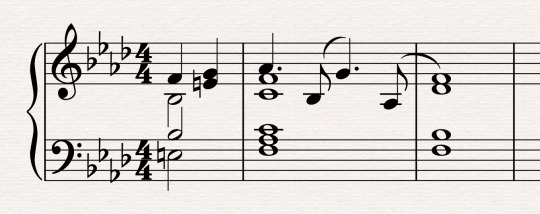
(soundtrack for Episode 3: Adar, Both Our Bloodlines, 00:36-00:52)


And secondly (you'll never guess where), during the log scene after the battle, developed further in Bb minor:

(soundtrack for Episode Six: Udûn, Transformed By Darkness, 05:34-06:09)


Knowing how fastidious Bear McCreary is with this score, which is filled to the brim with masterful uses of leitmotifs, and the immense care he took developing those melodies, I have a very strong (and hopeful) suspicion this is another.
But what does this theme signify? Is it Galadriel and Halbrand/Sauron's present/future love theme? Does it refer to the tragedy of their partnership, in whatever form that partnership takes? Or is it Sauron's theme alone, colouring the tragedy of a fallen Maia trying desperately to seek peace and redeem himself?
In favour of being their theme in some way, there is:
Shape of the melody: the leaping 6th intervals closely resemble, or at least echo, Bronwyn and Arondir's wistful and moving love theme, with its longing and impossibility (for them, Human and Elf relationships; for Galadriel and Sauron...)
Timing: the first instance of this motif lands perfectly behind Galadriel's words 'for you are him' (a double entendre), followed by Halbrand's 'That's an odd thing to say to a man in a cage'. The second instance is even more strongly linked to their relationship, coming directly after the dialogue:
'If I could just hold onto that feeling, keep it with me always, bind it to my very being, then I...'
'I felt it too.'
Or, only the most romantic (or cosmic) moment between them in the series.
What do you think? What might these moments and this theme symbolise narratively? Is there anywhere else in the score you can hear it?
(And Bear McCreary, if you happen to read my humble theorising and are at liberty to confirm either way, or to offer enlightening words of wisdom, please do. If not, keep it up. We love your work.)
________________________________________________
*I've done my best at transcribing the harmonies but do not claim perfection, and similarly the rhythms are indicative sketches only. Hopefully I'm right and Bear will give us the official version in a blog post some day. All copyright lies with the composer. I also may update this with more meta or thoughts later.
#the rings of power#the lord of the rings: the rings of power#rings of power#trop#trop meta#bear mccreary#composition#galadriel#halbrand#sauron#haladriel#saurondriel#galadriel x halbrand#halbrand x galadriel#rop spoilers#trop spoilers#rop meta#rop#film scoring#musing music things
147 notes
·
View notes
Text
Hi, you can call me Merce
Hello, I'm Merce. I'm white, American, aroace, and I have ADHD. I post rants, analysis, and web weavings on here
Interests include: Classic Literature (clit, as I call it), Films, Manga, and occasionally Musical Theater, Comic Books Video Games, Cartoons and various other TV shows. I prefer the act of reading over watching though.
Hyperfixations: Tatsuki Fujimoto's works, Naoki Urasawa's works, Mob Psycho 100, Hunter x Hunter, Revolutionary Girl Utena, Trigun, Undertale, The Sandman, Lisa the Painful, Lord of the Rings, Alien 1979, The Thing 1982, Gravity Falls, Over the Garden Wall, Neon Genesis Evangelion, Scott Pilgrim, Steven Universe, Bone
#chainsaw man#naoki urasawa#naoki urasawa's monster#naoki urasawa's pluto#billy bat#20th century boys#trigun#trigun maximum#revolutionary girl utena#hunter x hunter#mob psycho 100#fire punch#tatsuki fujimoto#undertale#lisa the painful#lord of the rings#lotr#alien 1979#the thing 1982#gravity falls#over the garden wall#otgw#neon genesis evangelion#nge#steven universe#classic literature#manga#film#musical theater#video games
16 notes
·
View notes
Text
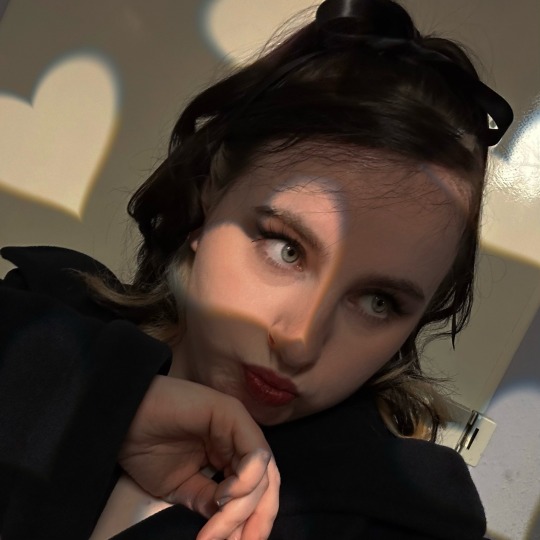

Wanna dress up and go out ? 🤍
#girl#you#look#so#cute#me#wunderschoeneluege#love#happy#date#dress up#concert#lord of the rings#film music#wanna be friends?
12 notes
·
View notes
Text



Aragorn in Elden Ring by Eli_Handle_b.wav
#Eli_handle_b.wav#Aragorn#Elden ring#the lord of the rings#Dominogodbane#Fromsoftware#mashup#Film#Movies#Video games#Gaming#Fantasy#Gif#The return of the king#Music#howard shore#Peter Jackson#J R R TOLKIEN#Youtube#Video#Epic#viggo mortensen
52 notes
·
View notes
Text
Man... I don't think I've ever been emotionally attached to something as much as I am attached to The Lord of the Rings. The books, the movies, the music... Oh, the music. I'm on the train right now and the journey is quite long, so I'm listening to some of my favourite tracks from the LotR score and I'm weeping. Seriously... The effect the music has on me... After all these years listening to The Breaking of the Fellowship, The Journey to the Grey Havens, Fellowship Reunited or The Departure of Boromir makes me cry and my heart hurts. The Battle of the Pelennor Fields, Forth Eorlingas, The Lighting of the Beacons, or The Crack of Doom still cause me goosebumps...
If I ever say that some other movie score is my most favourite, fell free to kick some sense into me. My most favourite ever is the complete LotR score. It has always been and always will be.
#howard shore what have you done to me?#it was the lotr score that made me start noticing and appreciating film music when i was a kid#and i will be forever grateful for that#lord of the rings#howard shore#filetmignon talks
12 notes
·
View notes
Text
hiii, its been a while since i dont post very often here. Sooo, what do you guys want to see mainly on my blog???
#byler#stranger things#the black phone#Slasher films#Horror movies#Horror books#Music#Heartstopper#Lotr#Lord of the rings#Im gonna add#Zombieland#Because im obsessed with it now
10 notes
·
View notes
Text


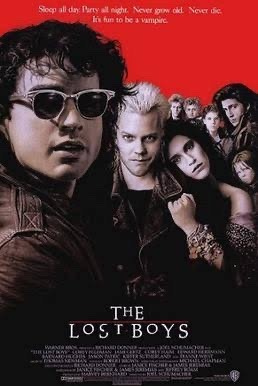



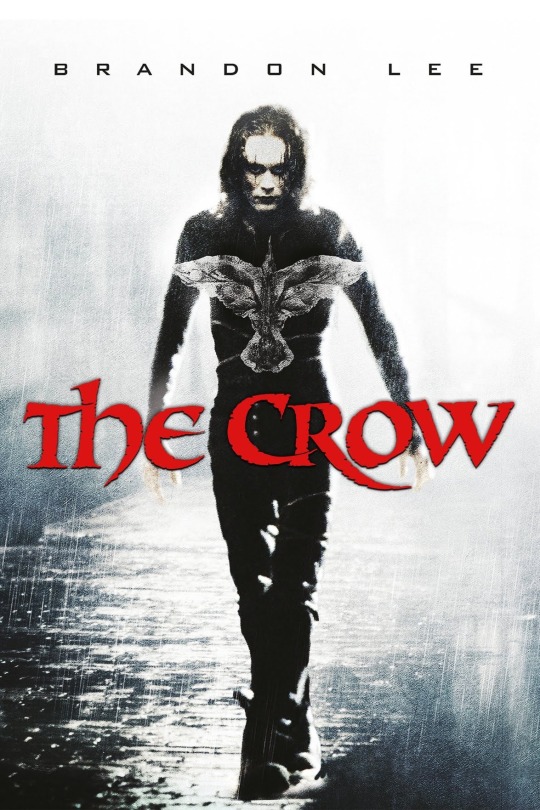


I’ve been tagged to show 9 of my favourite movies. Thank you @endlessdreamerxoxo 😊
#cinema#lord of the rings: the fellowship of the ring#labyrinth 1986#the lost boys 1987#Bambi#10 things i hate about you#the hobbit: an unexpected journey#the crow film#sleepless in seattle#the sound of music
28 notes
·
View notes
Text
In Fellowship, the Ring's themes recur in similar orchestrations, keys and styles, suggesting the Ring in its dormant state. The Two Towers allows the Ring material to change in degrees - a weightier orchestration here, a connection to Gollum there. But The Return of the King marks the point at which the score's preoccupation with the Ring's themes turns to obsession.
- Doug Adams, The Music of the Lord of the Rings Films
(I love the way this book describes the score of these movies so much)
153 notes
·
View notes
Text
any song that makes my chest ache and my stomach twist and a wail build in my throat gets the "this is so frodo" honors
#examples include#exit music for a film#door by mitski#most things by mitski#chelsea by phoebe bridgers#for real by okkervil river#the leanover#the list goes on#lord of the rings#crying over frodo again#frodo baggins#frodo#lotr
36 notes
·
View notes
Text
On the Friendship Onion beloved hobbits Billy Boyd and Dominic Monaghan talk with Composer Bear McCreary (TRoP, The Walking Dead, ...) about music in film and on TV.
youtube
#dominic monaghan#the friendship onion#podcast#billy boyd#lotr trop#trop#bear mccreary#hobbits#lotr#tolkien#the lord of the rings#the rings of power#film music#Youtube#howard shore#creative process#composer#film making
6 notes
·
View notes
Text
Bear McCreary, Michael Giacchino and Daniel Pemberton lead 2022 International Film Music Critics Association (IFMCA) nominations
Bear McCreary, Michael Giacchino and Daniel Pemberton lead 2022 International Film Music Critics Association (IFMCA) nominations

View On WordPress
#avatar the way of water#bear mccreary#Daniel Pemberton#guillermo del toro&039;s pinocchio#ifmca#international film music critics association#michael giacchino#nope#the batman#the fabelmans#the lord of the rings: rings of power
2 notes
·
View notes
Text
My top ten comfort films (as of 2/1/23)
Stardust

Matilda
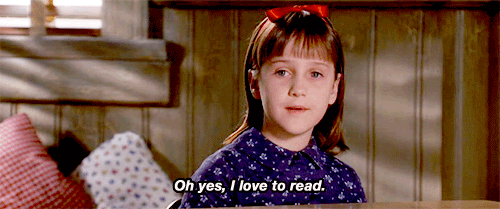
The Lion, The Witch and The Wardrobe
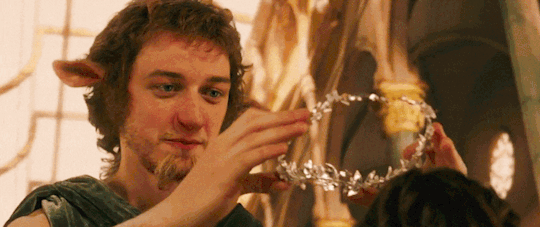
Anastasia

Spirited Away

Coco

How to Train Your Dragon

The Mitchell’s Vs the Machines
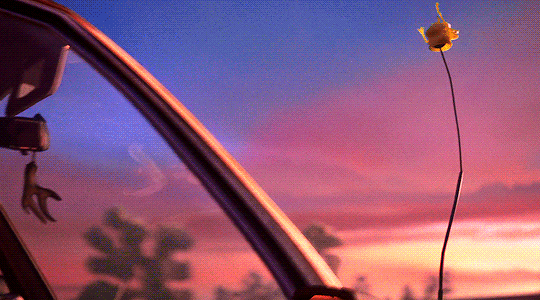
The Lord of the Rings (all)
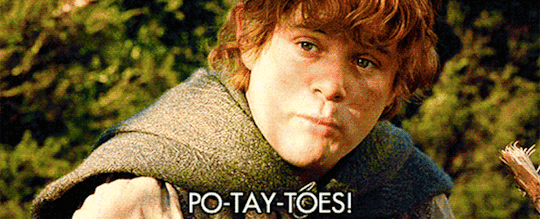
The Sound of Music

#comfort#films#lord of the rings#the mitchells vs the machines#how to train your dragon#stardust#the sound of music#coco#spirited away#anastasia#matilda#the lion the witch and the wardrobe
3 notes
·
View notes
Text
Music of the Shire
Here's a fun topic I know a bit about, since I researched it heavily for a music project in high school once. I think it's really fascinating, so that means I'm going to subject as many people as possible to an essay about it. Enjoy!
----------------------------------------------------------

(Image ID: A wide view picture of The Shire, from Lord of The Rings.)
I think just about everyone who's seen the Lord of the Rings trilogy can hum (or at least remember with a vague fondness) the main theme melody for the Shire/Hobbits. If you can't, well, here it is in its most plain form, for reference. This one melody is easily the most recognizable part of the score as a whole, which is incredibly impressive considering just how gargantuan the score is in both scale and musical richness.
Now, there's no doubt that the Shire Theme is beautiful - it has this wonderfully gentle rising/falling quality to it, as if the music itself were embodying the rolling hills of Hobbiton. But I think the reasons that it sticks with you so well after watching the trilogy go beyond the musical beauty of it, and into the absolutely genius ways that this one melody is thread throughout the three films, assuming a new musical/narrative context with each appearance.
These contexts are called settings, according to Doug Adams, the pre-eminent LOTR musicologist, and if I'm honest, I'm absolutely obsessed with them. The way that they're used to shape this one theme and turn it into something that defines an entire trilogy is incredibly fascinating to me, and has changed the way I think about film music. If this sounds interesting to you at all, then stick around and join me for a little dive into the world of the Shire and it's music.
(Warning: lots of music nerd stuff up ahead.)
Part 1: The Theme Itself

(Image ID: Sheet music for the Shire Theme, with the first half highlighted a separate color from the second.)
Before we can start talking about settings, we need to define what the Shire Theme actually is. The music pictured here is taken directly from the song In Dreams, from the end-credits sequence of Fellowship, which I linked to before but will now link to again (Don't worry if you can't read musical notation, I still love you).
This is the closest we can get to the most basic form of the Shire Theme, without the extra ornamentations that are usually added in other contexts.
Now, the reason that I've highlighted the two halves separately is because these two are actually considered distinct themes: Shire A, and Shire B, or the verse and chorus of In Dreams, respectively. Shire A is the one you're probably most familiar with, appearing most often. But Shire B has its place too, and is just as relevant.
As you can see/hear, Shire A is more gentle and relaxing, with the 'hilly' style melody and lots of second/third intervals. Shire B, on the other hand, is more dramatic, with these soaring ascensions that really grab the audience and shout "LISTEN! I'M PRETTY!" directly into their ear.
Got all that? Brilliant.
Part 2: The Pensive & Rural Settings
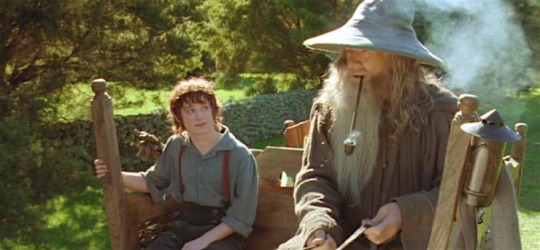
(Image ID: Frodo and Gandalf sitting on a cart together, talking.)
I'm going to kick off the setting discussion by talking about the two that you're probably most familiar with, because they dominate the majority of the early-trilogy Hobbiton scenes. In fact, if you pull up Concerning Hobbits off the soundtrack here, then you have a pretty good place to start when dissecting these two and the relationship between them, as they're intertwined throughout.
The Pensive Setting is the very first one you hear on that track, right after the little plucked-string opening (which, incidentally, is called the Outline Figure). The reason it's called that is because, generally, this setting is used to inspire a feeling of calmness, serenity, and affection toward the Shire. You can often pick it out because it's being played on a soothing instrument like strings, or in this case, a tin whistle, playing the Shire A melody.

(Image ID: Sheet music for the Pensive Setting of the Shire Theme.)
If you compare this to the basic version from In Dreams then you can see a pretty big difference - the rhythms are more free flowing, not particularly beholden to the beat and with plenty of extra notes added in-between for smoothness. You can still tell it's the same melody, though.
The Rural Setting of Shire A starts up right after -where the Pensive Setting gives a general sense of contentment with the Hobbits' way of life, the Rural Setting is more about Hobbiton itself and the folksy, lighthearted fun that takes place there in the early scenes. That's why, once Frodo leaves home, it isn't heard again until the end of the trilogy.

(Image ID: Two hobbits, looking very disappointed.)
(Unfortunately, I couldn't get proper sheet music for the Rural Setting. You can hear, it though.)
This setting is played on a fiddle here, and in fact is accompanied by a whole bunch of folk instruments that add to the lighthearted feeling, alongside the fun melodic variations that are included (syncopation, trills, etc.) that contribute to the fun atmosphere. Not too much else to say about this one, considering its short appearances.
If you keep listening to Concerning Hobbits, it becomes easier to pick out the changes between the two settings. For example, right after the fiddle section, some lush strings pick up the Pensive Setting again, but this time playing the Shire B version. Then the Rural Setting actually gets its own unique conclusion, separate from either version of the melody.
Next time you watch through the beginning of Fellowship, try pick out which setting is playing in a given scene! It's very fun.
Part 3: The Hymn Setting
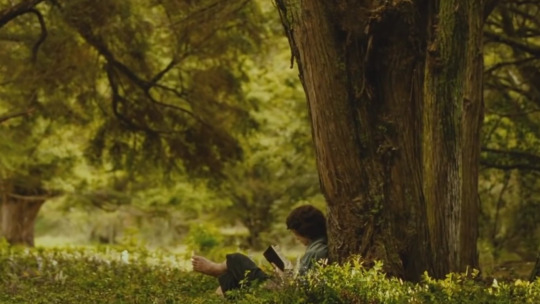
(Image ID: Frodo sitting under a tree, reading.)
This is where things really start to get interesting. The Hymn Setting is very important, because it's the one that makes you cry. In any situation where the hobbits, especially Sam and Frodo, are feeling homesick or mourning the loss of their simple lifestyle, then you'll probably hear the Hymn Setting.
If we jump back to In Dreams again, then you might notice that there's a series of chords playing underneath the melody, lasting two beats each. That's because these are the Hymn Chords, and I was LYING to you when I said In Dreams didn't have a setting (Okay, I didn't say that, but I implied it).
In actuality, In Dreams is practically one long instance of the Hymn Setting, but it still works as an example of the basic melody because the Hymn Setting doesn't have anything to do with the melody, only the accompanying harmony.
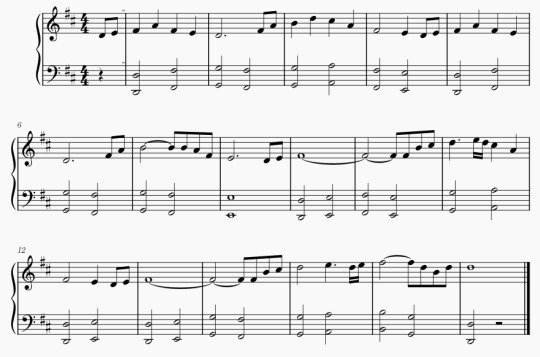
(Image ID: The same sheet music of the Shire Theme from earlier, with added chords.)
These are the so-called Hymn Chords, named that because they are intended to evoke a chorale effect found in traditional Western religious music, according to Doug Adams. Now, if I wanted to, I would go into a long musicological analysis of why these chords make the melody sound more melancholic, but this post is long enough already, so I won't.
Just know that these things are everywhere in the most emotional scenes of the trilogy, like the ending of Fellowship, or "My friends, you bow to no-one," and I'm half-convinced these simple chords are responsible for a few swimming pools full of tears.
What makes the Hymn Chords even more interesting are their connection to Frodo, and a special variation on the melody, called...
PART 4: A Hobbit's Understanding

(Image ID: A picture of Frodo crying.)
This one is special, because it's not so much a setting as a melodic variation on the Hymn Setting. That being said, it's very important, and worthy of its own section.
A Hobbit's Understanding is sort of an 'epiphany' theme, kept for whenever Frodo is confronted with some terrible situation that forces him to come to a certain realization (this is why I like to call it Frodo's Theme, as well.) Here are some examples:
When Bilbo talks to Frodo alone at his party, and the young hobbit gets some insight into a deeper pain in the old man.
In his soul-searching conversation with Gandalf in Moria - "I wish the Ring had never come to me..."
At the moment when Frodo recalls these words and decides to leave the Fellowship at Parth Galen (see image above).
When Sam follows Frodo anyway and he is forced to admit his need for companionship.
At the end of the Two Towers, when Sam gives his speech about the lasting good in the world.
You can hear it best here, in The Breaking of The Fellowship.

(Image ID: Sheet music of A Hobbit's Understanding.)
You can instantly recognize this melody by those three upward movements at the beginning (and the Hymn Chords underneath). In Shire B, which this example is based off of, there are only two upward movements. If you scroll back up to that original sheet music, you can see the foundation that this melody is based on, and the points that it differs.
The really effective part about this melody, for me, is how is mirrors the feeling of an epiphany. Those three rapid ascensions at the beginning are the realization itself, which goes on to slowly solidify in Frodo's mind as the melody itself descends back onto that oh-so-satisfying D note at the end. It's absolute magic.
Part 5: Conclusion

(Image ID: Merry, Frodo, Sam, and Pippin standing, surrounded by bowing people.)
There are a few other minor melodies and settings that are used infrequently, but I'm satisfied with having discussed the main ones. I hope this has provided a bit of an insight into the wonderful world of leitmotifs, and added something to your next LOTR viewing.
Personally, I find the different setting and variations of the Shire Theme utterly fascinating. If you want to read more about it, follow the link posted below in the credits.
This was a pretty big post to make to kick-off this tumblr, and I'm not sure if I'll make one this big again, but we'll see. Thanks for reading all the way through, if you in fact did. Follow if you wanna see more stuff like this, and have a great day!
CREDITS
The organizational system used for the themes is borrowed from an old LOTR soundtrack blog called the Magpie's Nest, which no longer exists, but can be found on the Wayback Machine here. The author of this site based his system on that of Doug Adams and his brilliant book The Music of The Lord of The Rings Trilogy, so credit is due to both of them.
The sheet music transcriptions used throughout come from an anonymous transcriber, and was published on the website of a fellow named Alcaeru, found here.
#lotr#music#lord of the rings#leitmotif#motif#music analysis#musicology#shire#frodo#hobbits#bilbo#howard shore#lotr music#essay#writing#film#score#theme#arrangement#transcription#thoughts#interesting#hobbiton#the shire#melody#harmony#film score#soundtrack#lotr movies#middle earth
6 notes
·
View notes